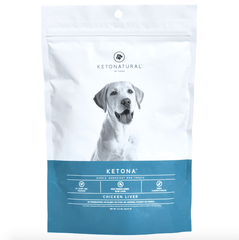Save Money, Save Your Dog.
Join Our Email List For Discounted Pricing and a Free Guide to the Science of Keto Dog Food.
Diabetic Dog Food and Carbs: What You Need to Know to Make the Best Decisions For Your Best Friend

Canine diabetes mellitus is one of the most common and serious endocrine disorders diagnosed in pet dogs. It's often debilitating, sometimes deadly, and almost always expensive to treat. Studies suggest that it's getting more common too.
In lay terms, the disease is characterized by having too much sugar (glucose) in the bloodstream and not enough in the other tissues that need it. But, in a way, the disease is less about glucose and more about the body's production and use of the hormone insulin.
Insulin's primary function is to drive circulating glucose into tissues like fat and muscle. In diabetic animals that process becomes dysfunctional, so more and more glucose stays in the blood instead. If left untreated, the resulting condition (hyperglycemia) can cause debilitating damage to the eyes, kidneys, and cardiovascular system.
There are a few different ways that glycemic control can become disrupted. In what's typically called insulin-deficiency diabetes (IDD), the pancreas simply stop producing enough insulin. In insulin-resistant diabetes (IRD), insulin production remains normal (or is elevated), but peripheral tissues become desensitized to the hormone, so they no longer suck up glucose effectively. In IDD, there's not enough insulin being produced; in IRD, the insulin no longer does its job effectively. In both cases, persistent hyperglycemia is likely to result without treatment.
Although treatment varies on a case by case basis, it typically involves (1) supplementation with exogenous insulin and (2) nutritional management. And while there are several factors that are relevant to determining the appropriate diet for a dog with diabetes, one is by far the most important---carbohydrate content.
The reason for this is simple: dietary carbohydrates are glucose. Some begin the digestive process as more complicated molecules (what are often called complex carbohydrates), but by the time they enter the bloodstream, they've all been broken-down into glucose molecules. That's why dietary carbohydrates cause blood sugar levels to rise so dramatically, while fats and proteins do not.
Nothing about this is remotely controversial. Every major veterinary nutrition textbook in circulation today highlights the unique importance of glycemic control to the nutritional management of canine diabetes. It is universally regarded as the most important dietary factor to be considered by caregivers.
What is controversial are the specific dietary strategies typically recommended for controlling glycemic response. None of the leading textbooks recommend a low- or zero-carbohydrate diet to help dogs manage their diabetes. Instead, they recommend strategies that are merely likely to slow (but not reduce) the delivery of glucose into the bloodstream: feed complex carbohydrates instead of simple ones, feed some fiber along with the carbohydrates, avoid "semi-moist" foods, etc.
Why not just tackle the problem directly and recommend carbohydrate restriction (or outright elimination) instead? After all, premium dry dog foods with less than 5% starch are now being produced. And veterinarians treating diabetes with zero-carbohydrate diets are having remarkable results. And, of course, dogs are more than capable of producing all the glucose their bodies need without any dietary carbs whatsoever. (That's why carbohydrates aren't considered essential nutrients for dogs, while proteins and fats are.)
I can only speculate about the answer to this question. That said, the answer does seem rather obvious to me when you consider these two facts:
(1) The two leading veterinary nutrition textbooks in circulation today were written by paid employees of Hill's Pet Nutrition and Proctor & Gamble Petcare, respectively.
(2) The diabetes formulas sold by those leading pet food manufacturers rely heavily on cheap, fattening, blood-sugar spiking dietary carbohydrates. For instance, more than half of the calories in Hill's Prescription Diet W/D Canine formula come from carbohydrates! (Glycobalance Dry Dog Food -- the diabetes formula produced by former P&G brand Royal Canin -- is only slightly better.) I'm sorry, that's simply scandalous.
If you're of the crazy belief that a diet with less than 5% starch might just be a better choice for your diabetic dog's glycemic control than one with more than 50% carbohydrate, then you should probably check out a premium dry dog food like Ketona. And if you want to read more about how to reduce your dog's carbohydrate intake, please re-visit our Ultimate Guide to Choosing a Low-Cost, Low-Carb Dog Food.
Learn more about diabetic symptoms in dogs.

Related Articles
How Much Does The Farmer’s Dog Really Cost?
5 Signs and Symptoms That Your Dog May Have Diabetes
Learning to Take Pleasure In Being Your Dog's Play Buddy-Drill Sargeant
Dogs, Dog Food and Dogma - A Book About America's Pet Obesity Epidemic
Browse Articles By Category